Trying out the camera settings when I climbed the hill to the reserve, I caught this honey bee on a Devil's Bit Scabious, Succisa pratensis.
I think this might be Common Rock-rose, Helianthemum nummularium, and something has been nibbling the edges of some of the leaves. There is a Brown Argus adult to the bottom right, but i don't think the damage is entirely typical of the Brown Argus caterpillar - but maybe its not too far off.
The Dogwood, Cornus sanguinea, was in full berry.
And the yew arils are coloured up as well:
There were a fair number of Carline Thistle, Carlina vulgaris, on the shallower soils at the top of the slope.
and I think this a Dwarf Thistle, Cirsium acaule - amazing tubular structure of the individual florets.
and quite a few possibly different "hawks" in flower, possibly different members of the Asteraceae.
One of the Guelder Rose plants was colouring up very well indeed!
There were fair numbers of Chalkhill Blues, Polyommatus coridon, on the reserve today, perhaps more up the hill than at the bottom. Here was a female that looked as though it was exploring laying an egg.
This is another female, settled on a fairly bare patch of chalk at the top of the hill, and in slightly better condition:
These quite bare patches are really interesting. If you look at the top photo above, you can seen a grey thallose lichen below the butterfly.
And here is a tough moss, partly dessicated, in the section below the nibbled plant.
This is another female with the fringes very much worn away, but otherwise I think recognizeable. The only really worrying thing is that I cannot see a white streak on the v4 of the rear underwing, so I cannot be sure that it is not a Common Blue:
This is a male Chalkhill Blue,
This is another male Chalkhill Blue:
and another:
and a close-up of another head:
Here on the other hand is apparently a worn but originally very blue form of the female Common Blue, Polyommatus icarus.
This is a suspected female, but definitely a Brown Argus from the rear underwing pattern of spots.

This is another Brown Argus, this time possibly a male:
I also came across this vicious looking Robber Fly:
















































